Answered step by step
Verified Expert Solution
Question
1 Approved Answer
GSH TERM-CONTRACTING IRREGULARITIES Background The Government Services Handling (GSH), frequently referred to as the housekeeper of the Federal Government, is an agency that deals in
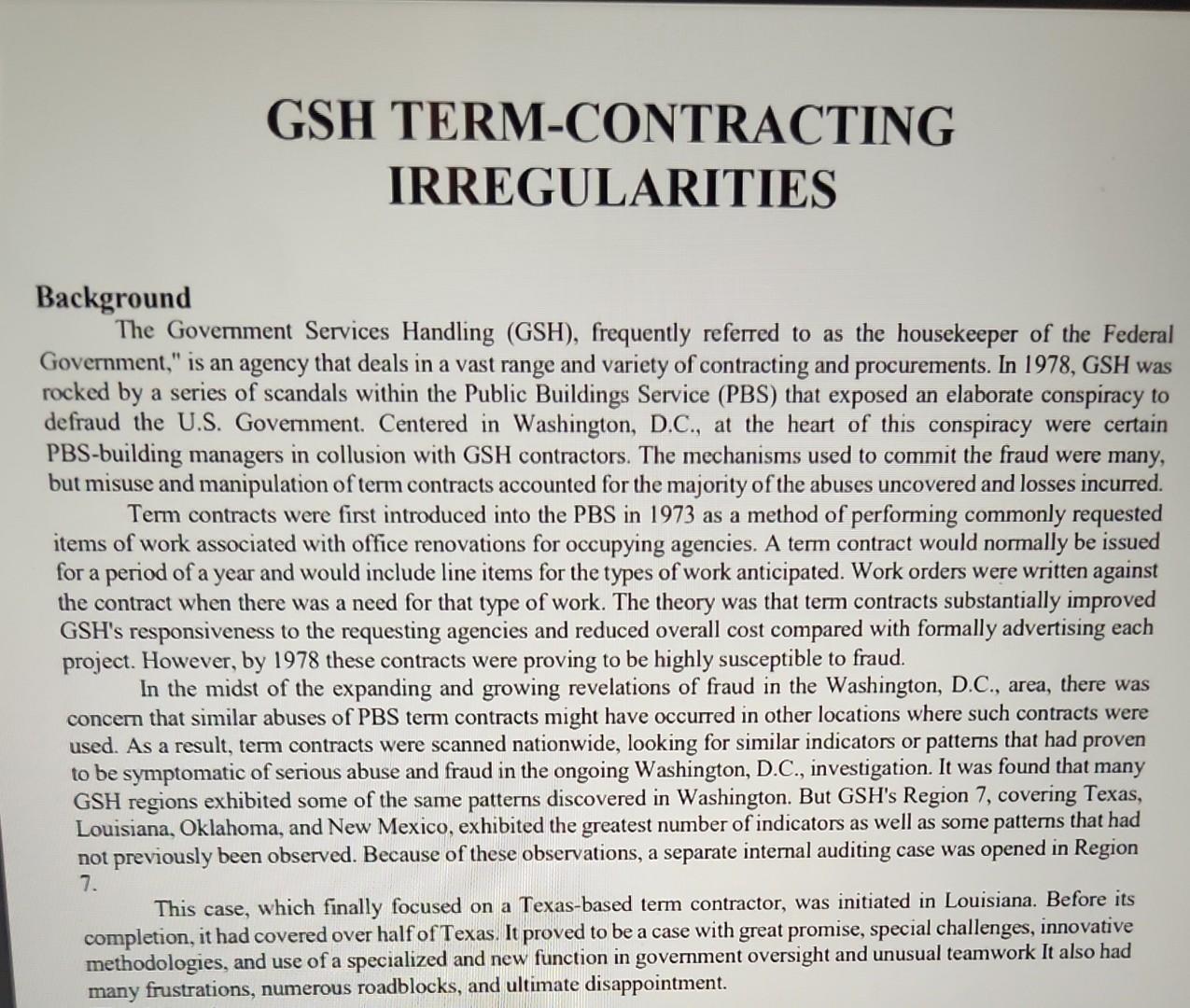
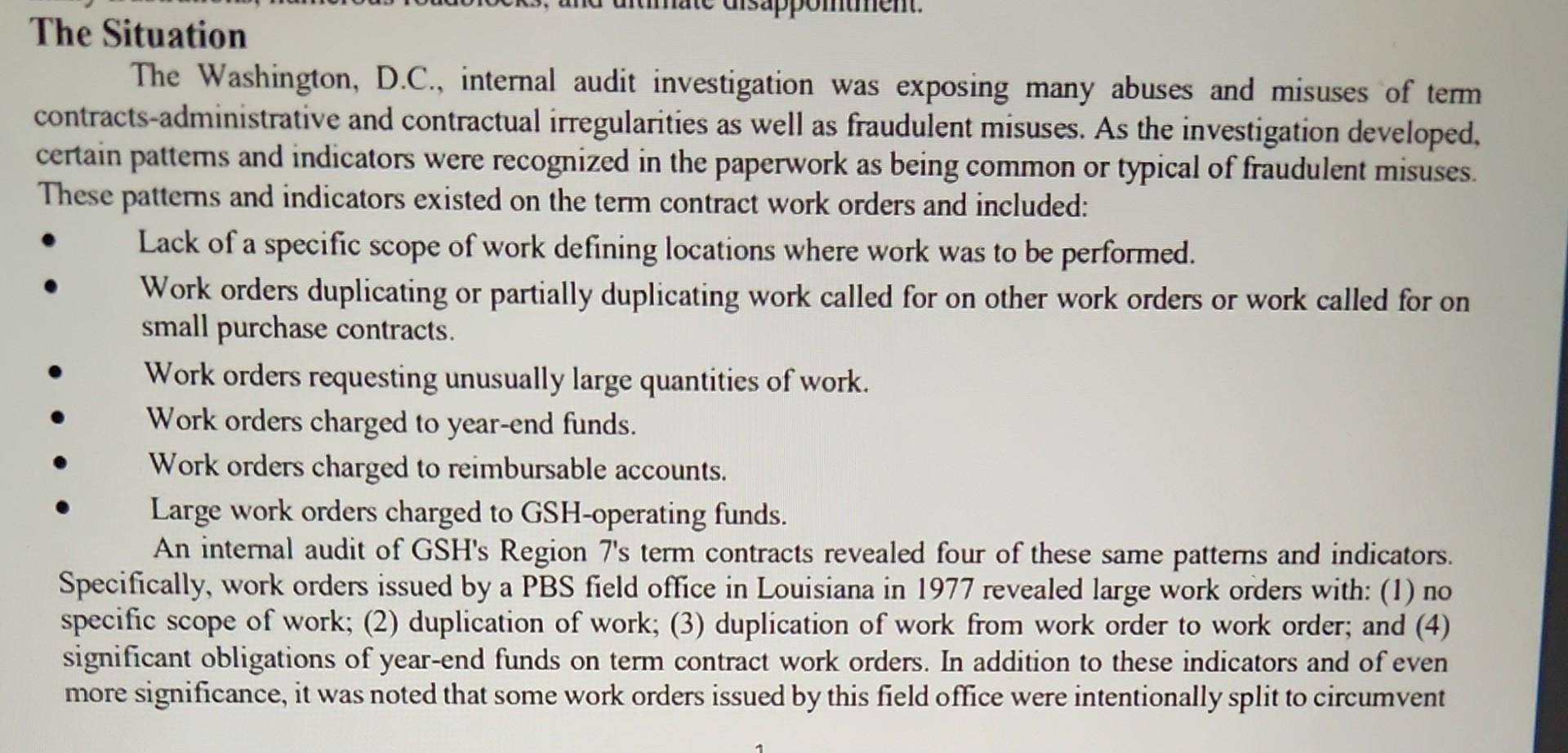
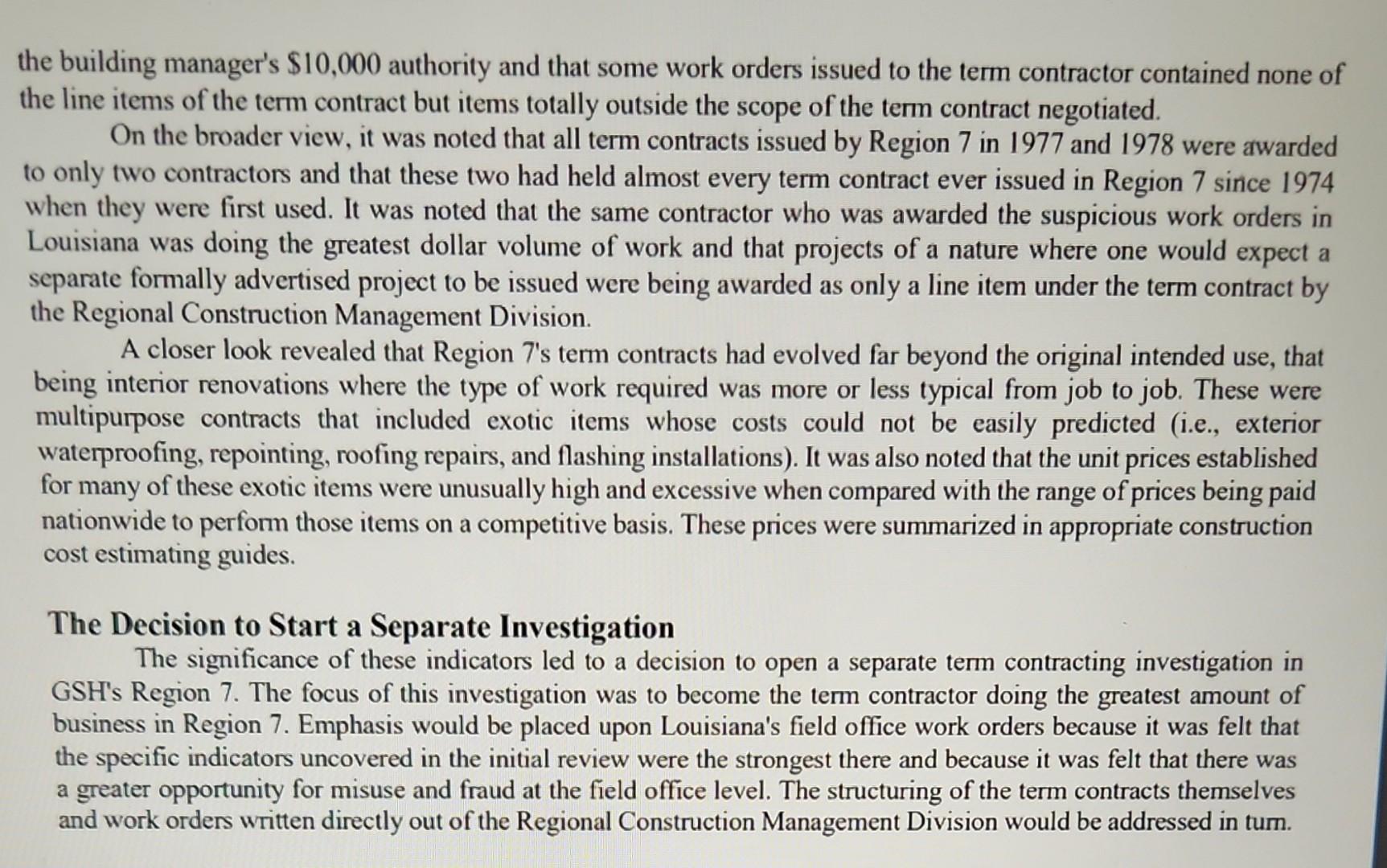
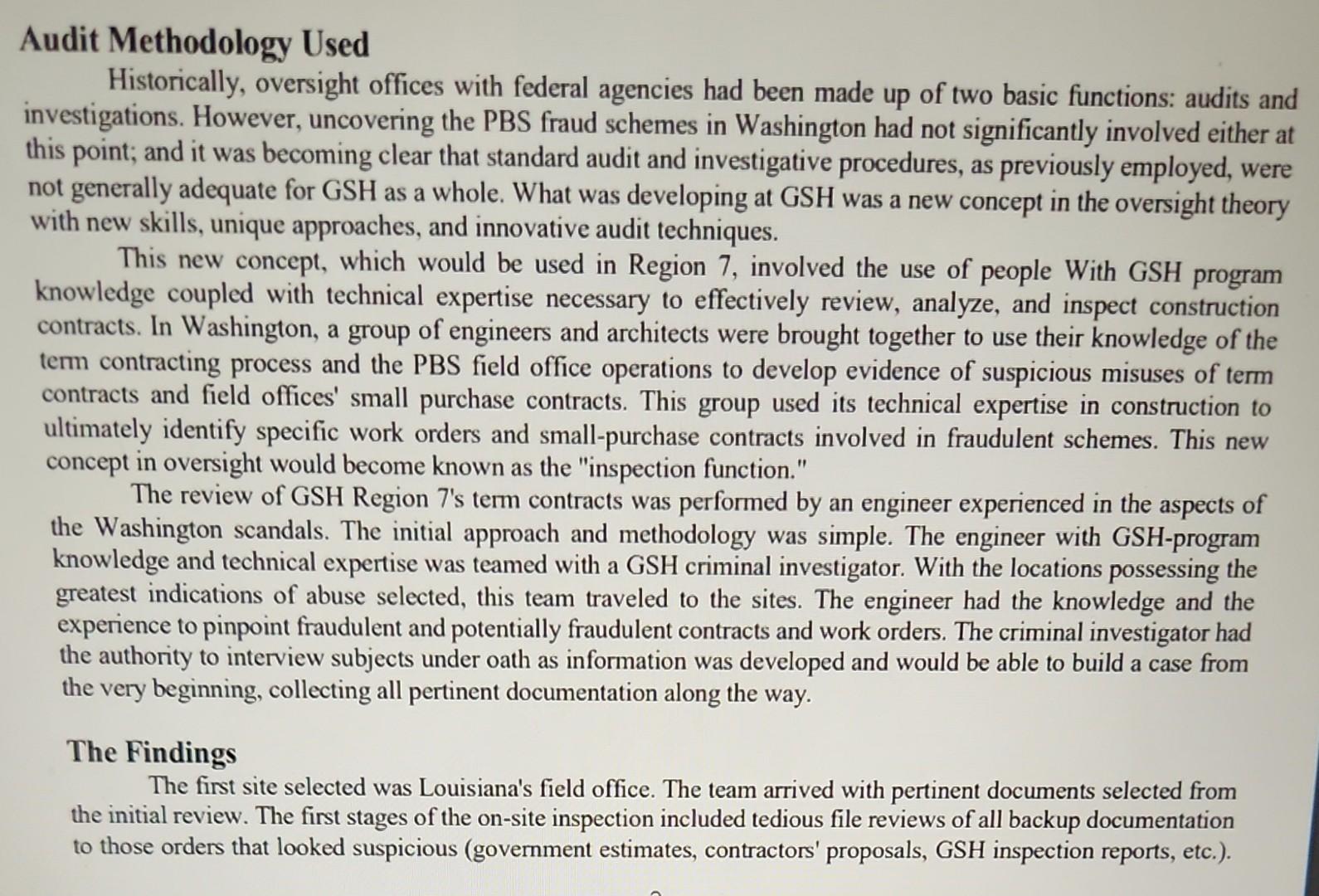
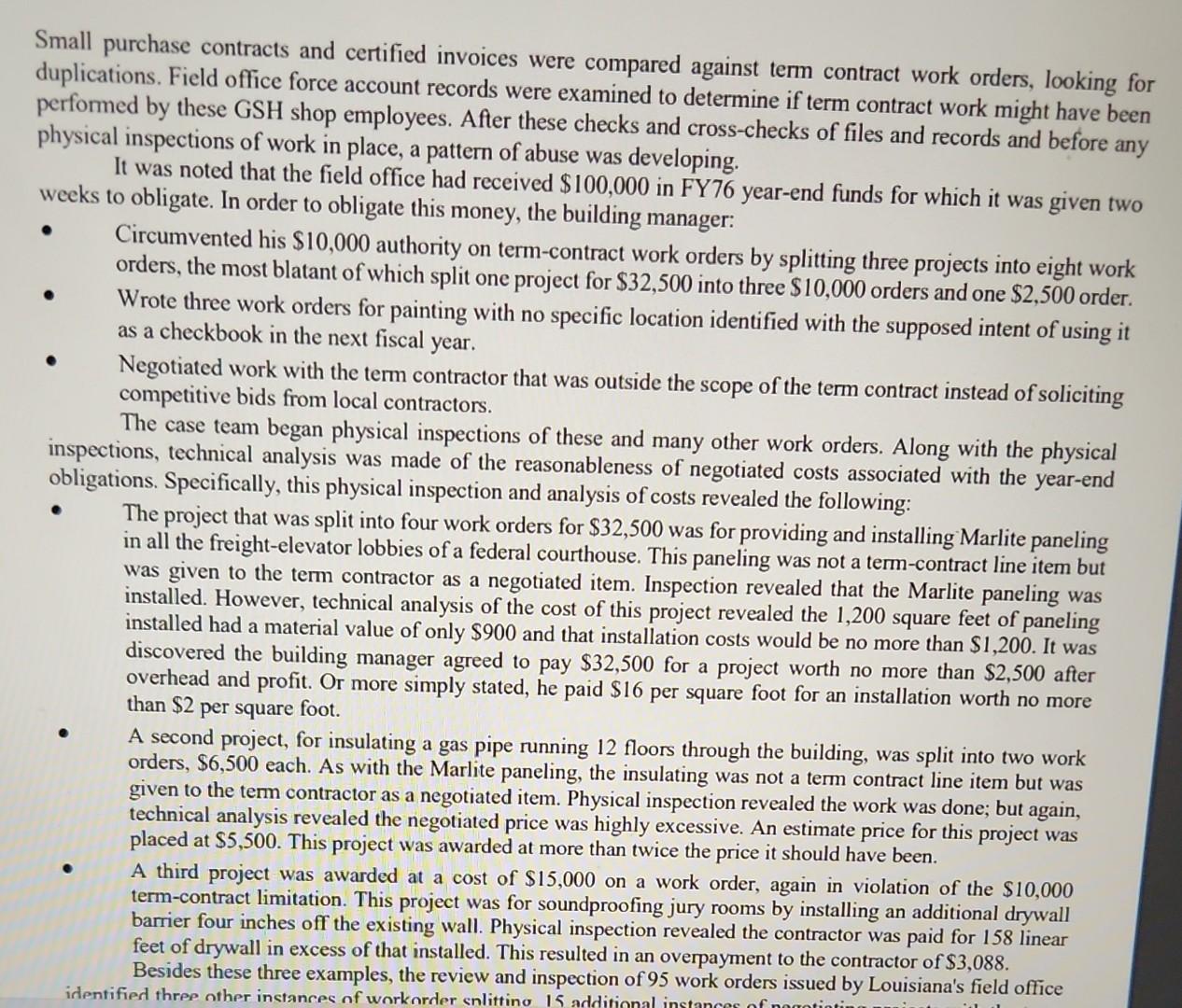
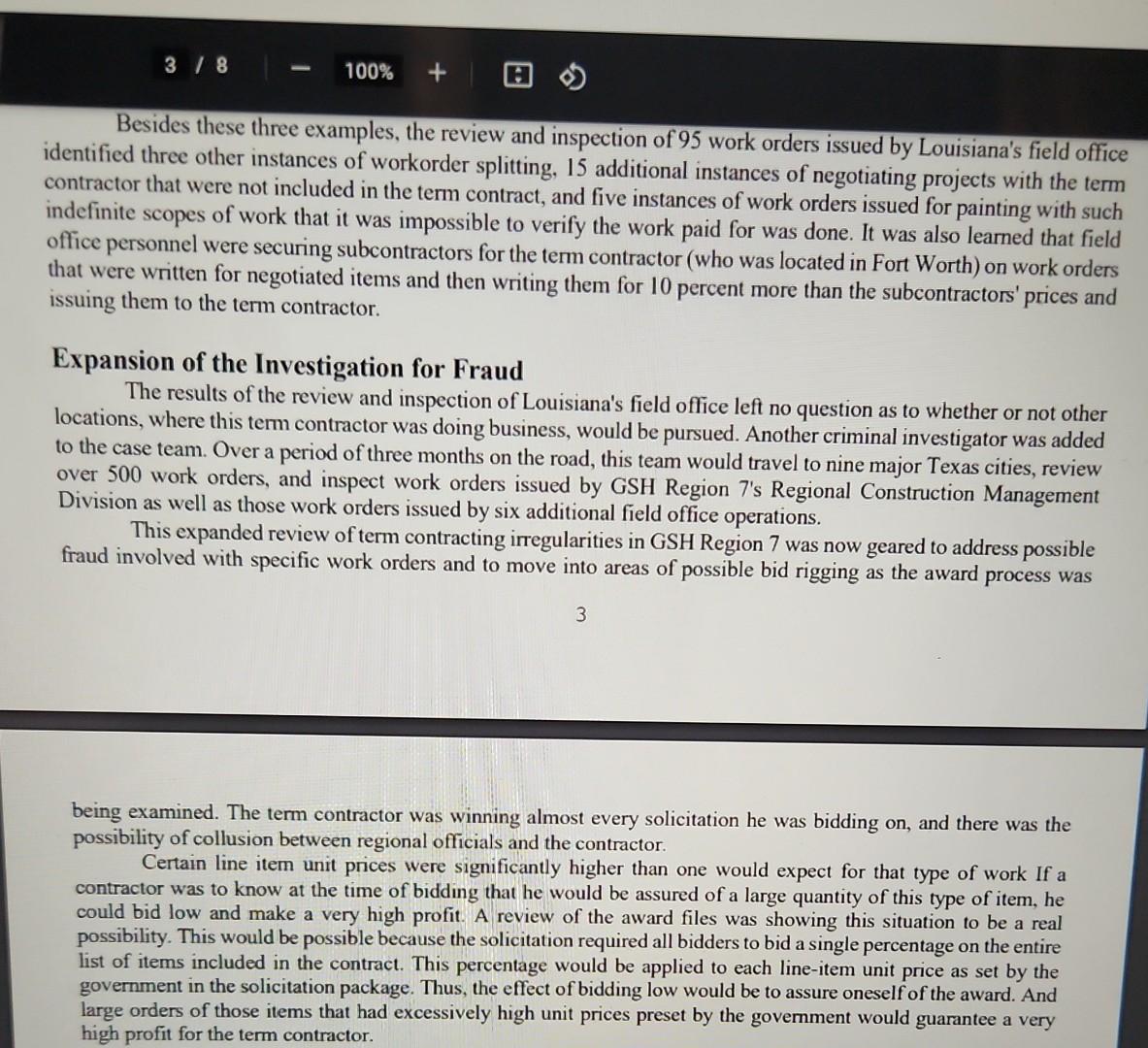
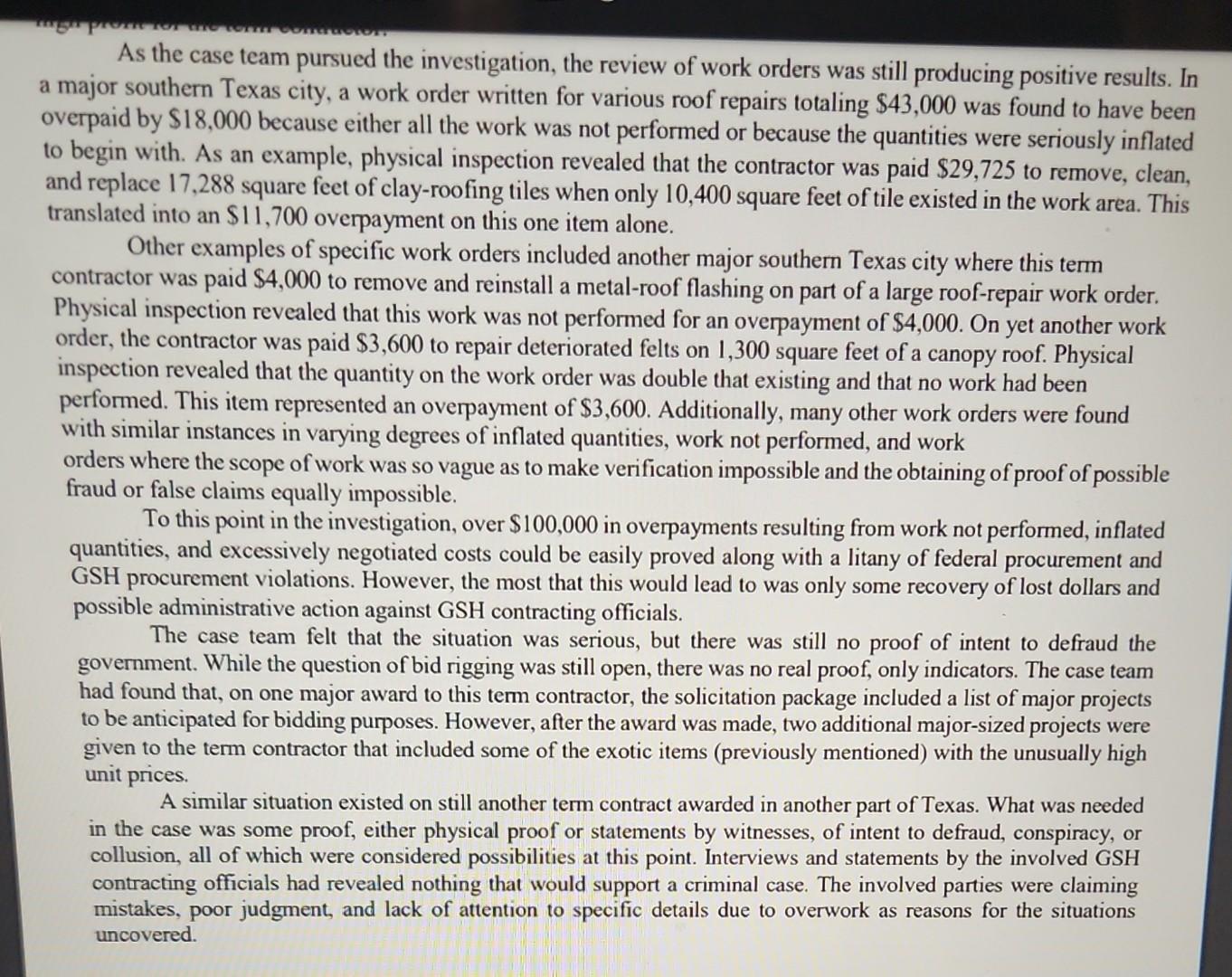
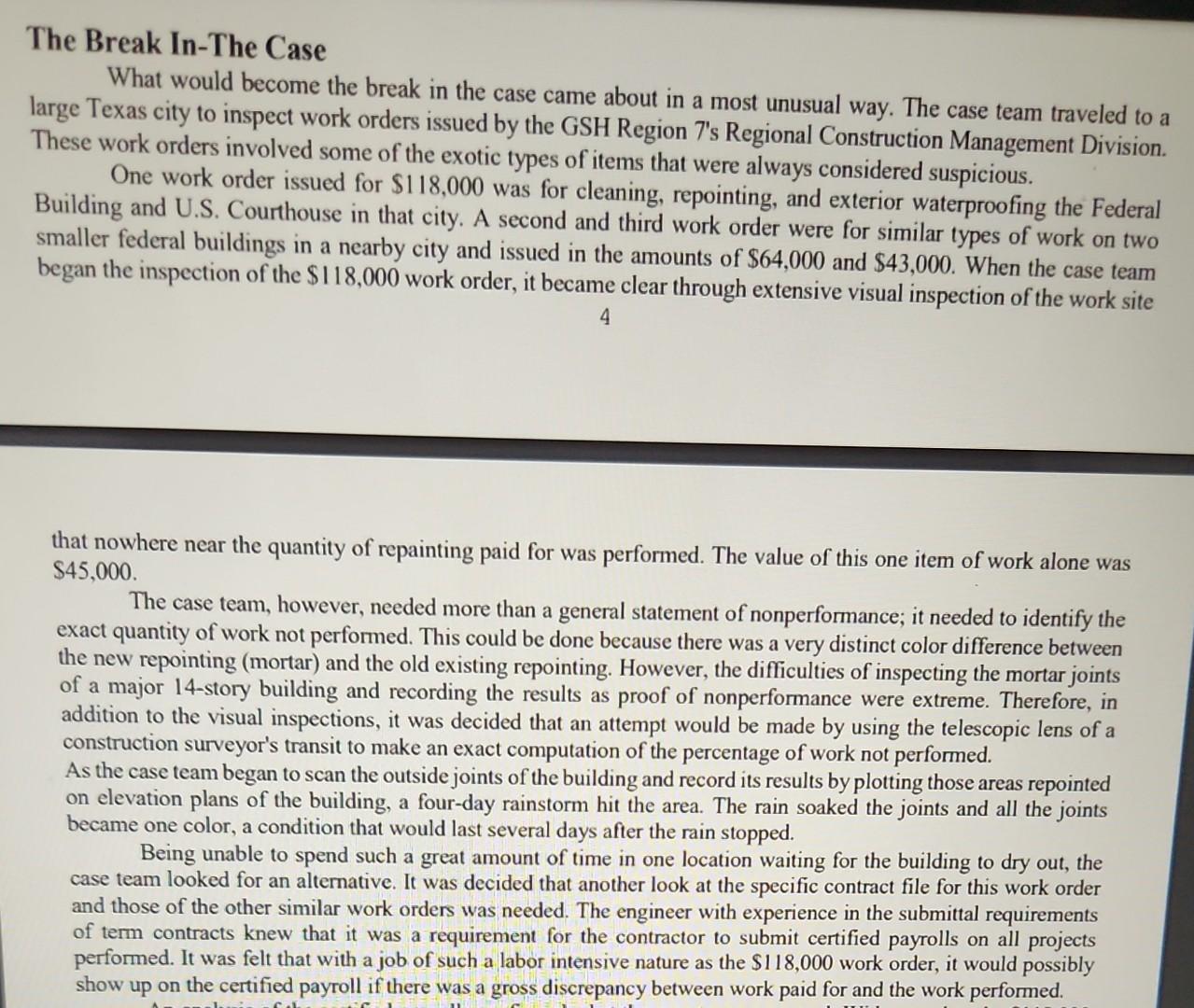
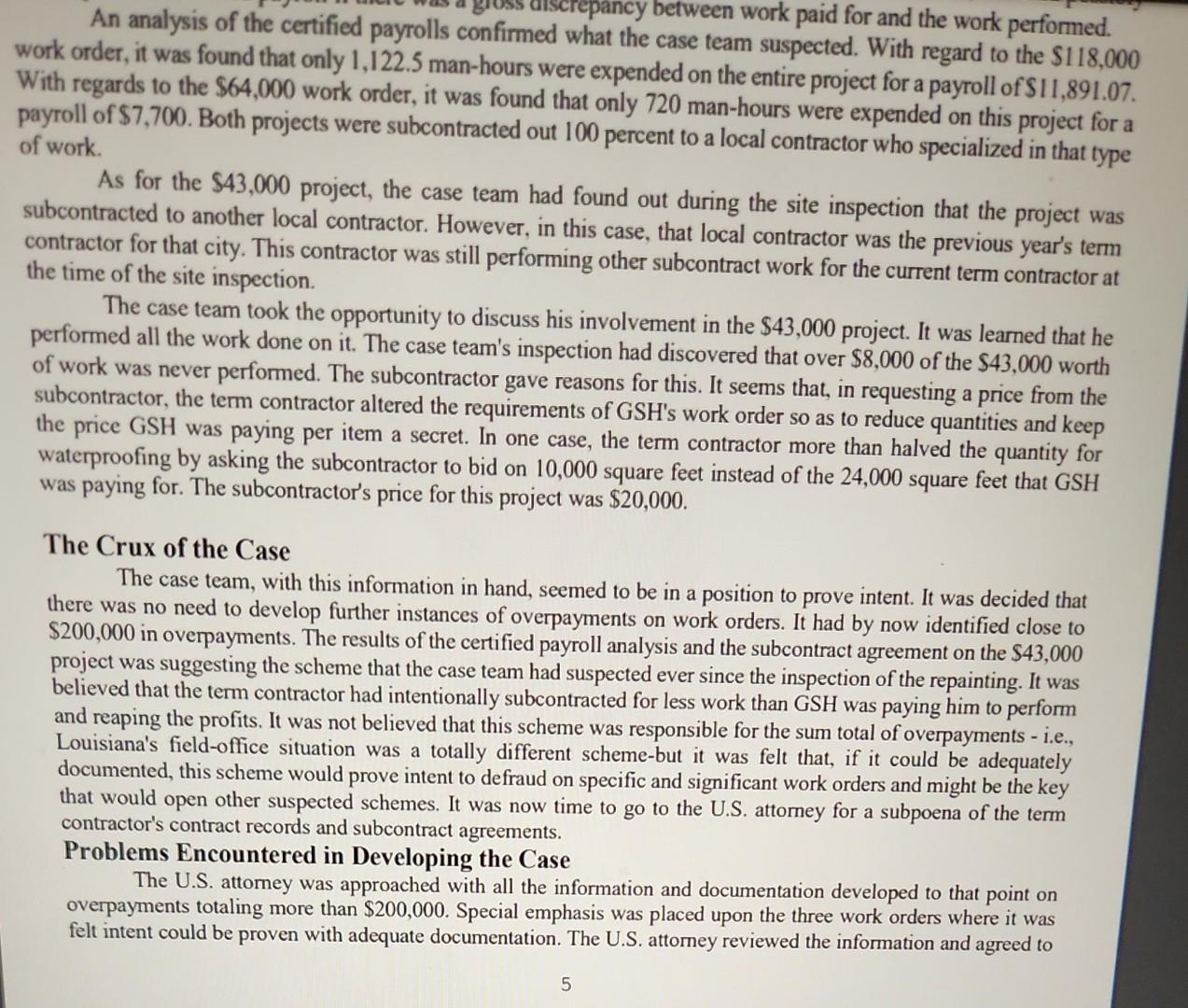


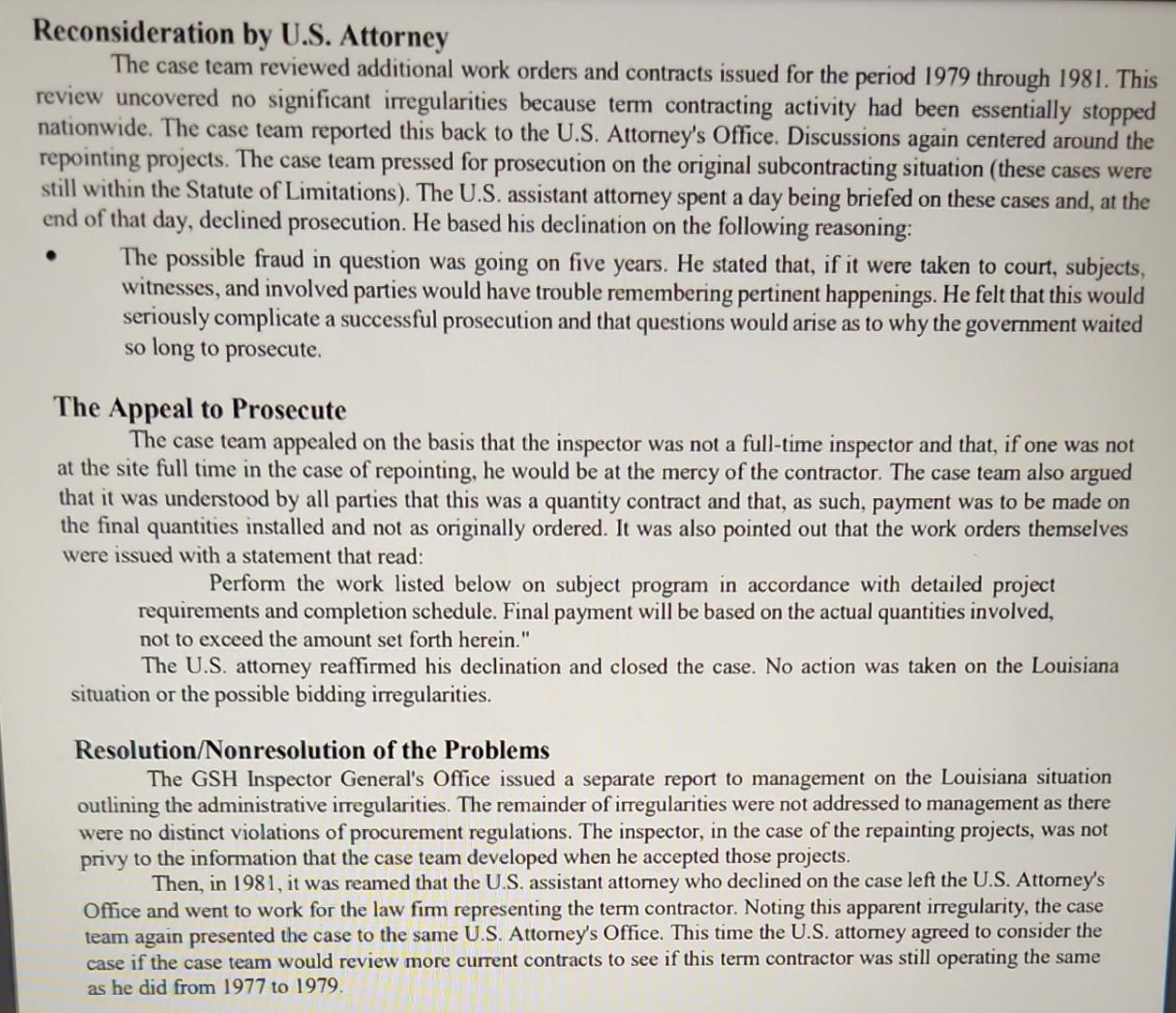
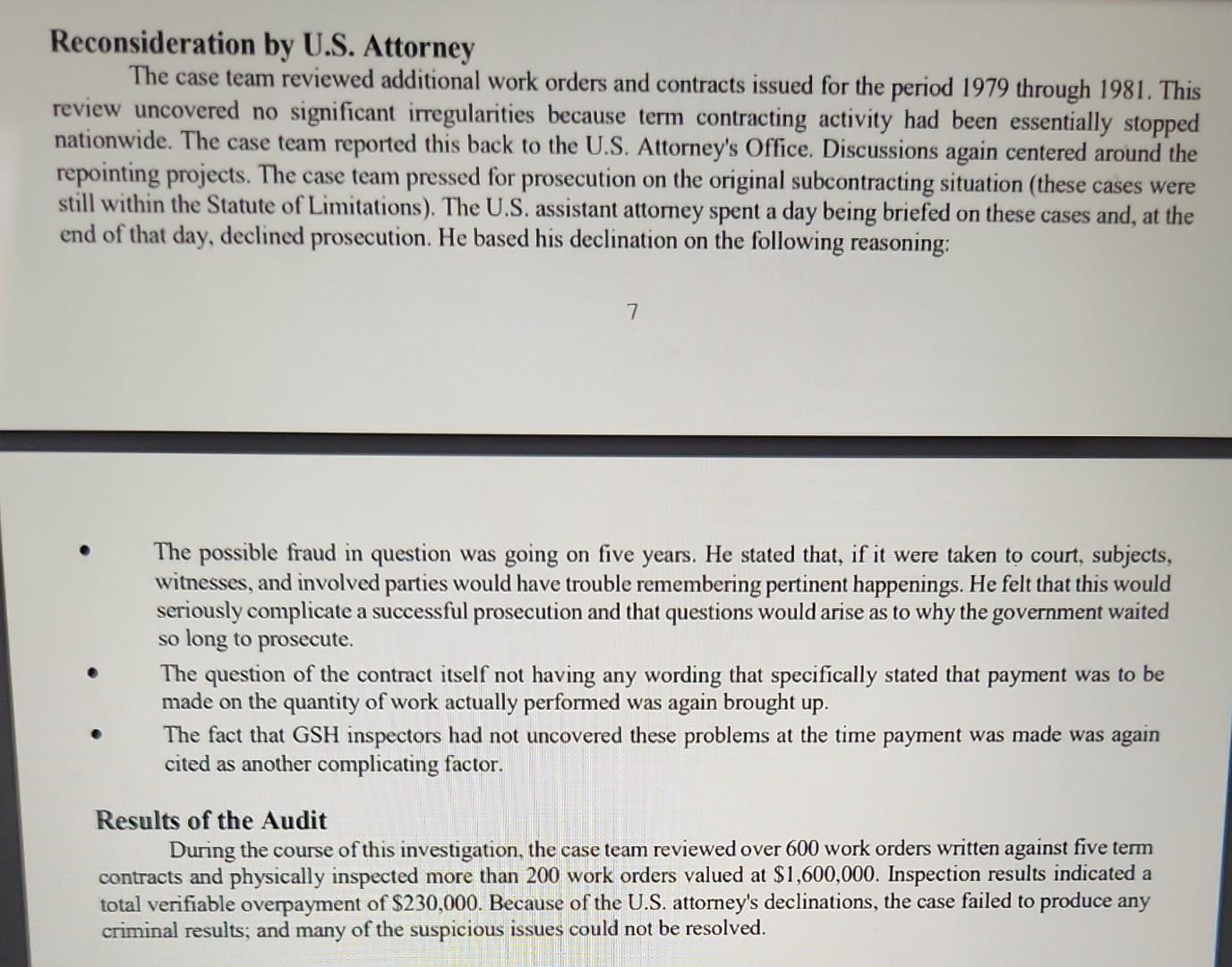
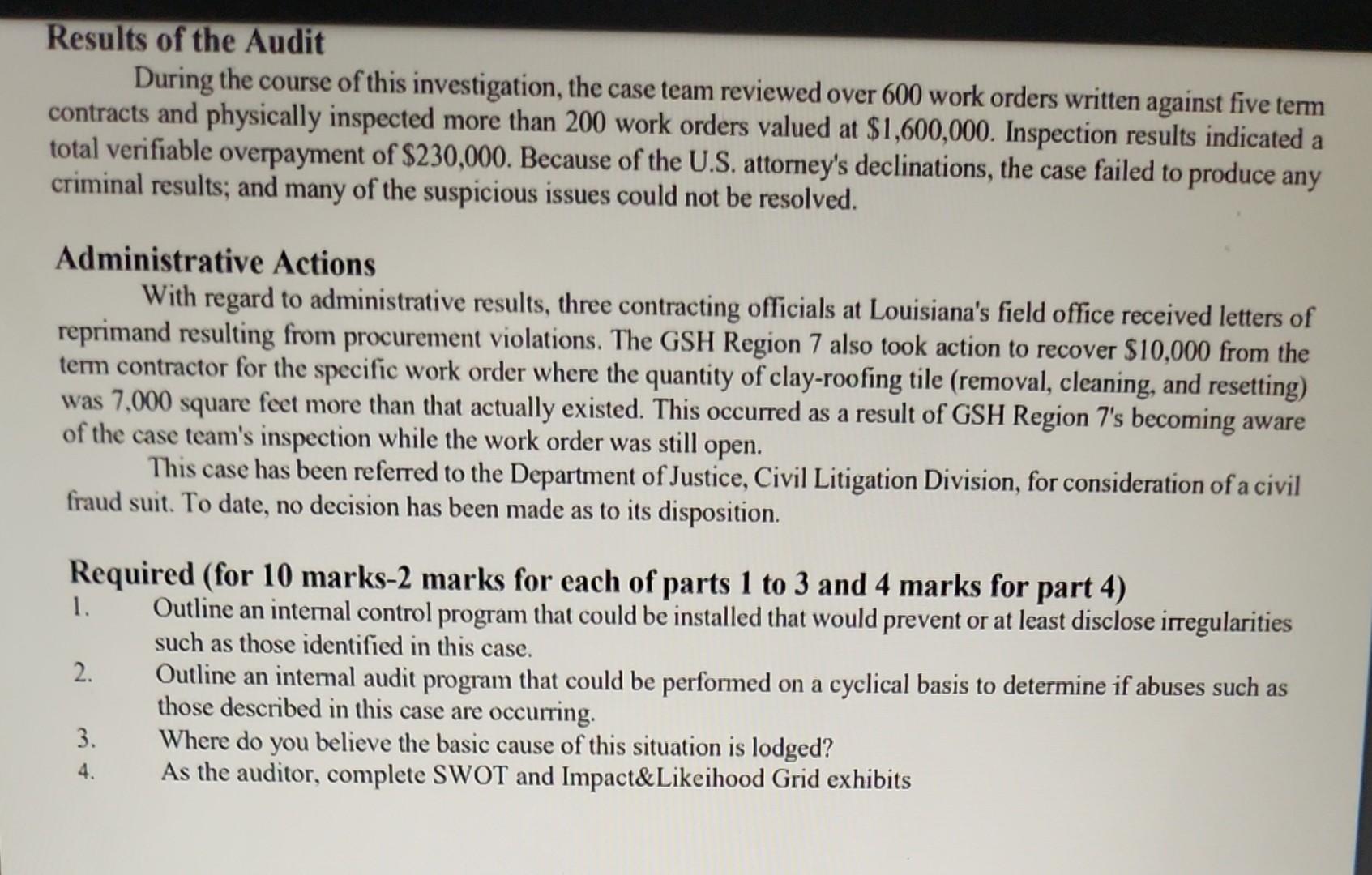
GSH TERM-CONTRACTING IRREGULARITIES Background The Government Services Handling (GSH), frequently referred to as the housekeeper of the Federal Government," is an agency that deals in a vast range and variety of contracting and procurements. In 1978, GSH was rocked by a series of scandals within the Public Buildings Service (PBS) that exposed an elaborate conspiracy to defraud the U.S. Government. Centered in Washington, D.C., at the heart of this conspiracy were certain PBS-building managers in collusion with GSH contractors. The mechanisms used to commit the fraud were many, but misuse and manipulation of term contracts accounted for the majority of the abuses uncovered and losses incurred. Term contracts were first introduced into the PBS in 1973 as a method of performing commonly requested items of work associated with office renovations for occupying agencies. A term contract would normally be issued for a period of a year and would include line items for the types of work anticipated. Work orders were written against the contract when there was a need for that type of work. The theory was that term contracts substantially improved GSH's responsiveness to the requesting agencies and reduced overall cost compared with formally advertising each project. However, by 1978 these contracts were proving to be highly susceptible to fraud. In the midst of the expanding and growing revelations of fraud in the Washington, D.C., area, there was concern that similar abuses of PBS term contracts might have occurred in other locations where such contracts were used. As a result, term contracts were scanned nationwide, looking for similar indicators or patterns that had proven to be symptomatic of serious abuse and fraud in the ongoing Washington, D.C., investigation. It was found that many GSH regions exhibited some of the same patterns discovered in Washington. But GSH's Region 7, covering Texas, Louisiana, Oklahoma, and New Mexico, exhibited the greatest number of indicators as well as some patterns that had not previously been observed. Because of these observations, a separate internal auditing case was opened in Region 7. This case, which finally focused on a Texas-based term contractor, was initiated in Louisiana. Before its completion, it had covered over half of Texas. It proved to be a case with great promise, special challenges, innovative methodologies, and use of a specialized and new function in government oversight and unusual teamwork It also had many frustrations, numerous roadblocks, and ultimate disappointment. The Situation The Washington, D.C., internal audit investigation was exposing many abuses and misuses of term contracts-administrative and contractual irregularities as well as fraudulent misuses. As the investigation developed, certain patterns and indicators were recognized in the paperwork as being common or typical of fraudulent misuses. These patterns and indicators existed on the term contract work orders and included: - Lack of a specific scope of work defining locations where work was to be performed. - Work orders duplicating or partially duplicating work called for on other work orders or work called for on small purchase contracts. - Work orders requesting unusually large quantities of work. - Work orders charged to year-end funds. - Work orders charged to reimbursable accounts. - Large work orders charged to GSH-operating funds. An internal audit of GSH's Region 7's term contracts revealed four of these same patterns and indicators. Specifically, work orders issued by a PBS field office in Louisiana in 1977 revealed large work orders with: (1) no specific scope of work; (2) duplication of work; (3) duplication of work from work order to work order; and (4) significant obligations of year-end funds on term contract work orders. In addition to these indicators and of even more significance, it was noted that some work orders issued by this field office were intentionally split to circumvent the building manager's $10,000 authority and that some work orders issued to the term contractor contained none of the line items of the term contract but items totally outside the scope of the term contract negotiated. On the broader view, it was noted that all term contracts issued by Region 7 in 1977 and 1978 were awarded to only two contractors and that these two had held almost every term contract ever issued in Region 7 since 1974 when they were first used. It was noted that the same contractor who was awarded the suspicious work orders in Louisiana was doing the greatest dollar volume of work and that projects of a nature where one would expect a separate formally advertised project to be issued were being awarded as only a line item under the term contract by the Regional Construction Management Division. A closer look revealed that Region 7's term contracts had evolved far beyond the original intended use, that being interior renovations where the type of work required was more or less typical from job to job. These were multipurpose contracts that included exotic items whose costs could not be easily predicted (i.e., exterior waterproofing, repointing, roofing repairs, and flashing installations). It was also noted that the unit prices established for many of these exotic items were unusually high and excessive when compared with the range of prices being paid nationwide to perform those items on a competitive basis. These prices were summarized in appropriate construction cost estimating guides. The Decision to Start a Separate Investigation The significance of these indicators led to a decision to open a separate term contracting investigation in GSH's Region 7. The focus of this investigation was to become the term contractor doing the greatest amount of business in Region 7. Emphasis would be placed upon Louisiana's field office work orders because it was felt that the specific indicators uncovered in the initial review were the strongest there and because it was felt that there was a greater opportunity for misuse and fraud at the field office level. The structuring of the term contracts themselves and work orders written directly out of the Regional Construction Management Division would be addressed in tum. Audit Methodology Used Historically, oversight offices with federal agencies had been made up of two basic functions: audits and investigations. However, uncovering the PBS fraud schemes in Washington had not significantly involved either at this point; and it was becoming clear that standard audit and investigative procedures, as previously employed, were not generally adequate for GSH as a whole. What was developing at GSH was a new concept in the oversight theory with new skills, unique approaches, and innovative audit techniques. This new concept, which would be used in Region 7, involved the use of people With GSH program knowledge coupled with technical expertise necessary to effectively review, analyze, and inspect construction contracts. In Washington, a group of engineers and architects were brought together to use their knowledge of the term contracting process and the PBS field office operations to develop evidence of suspicious misuses of term contracts and field offices' small purchase contracts. This group used its technical expertise in construction to ultimately identify specific work orders and small-purchase contracts involved in fraudulent schemes. This new concept in oversight would become known as the "inspection function." The review of GSH Region 7's term contracts was performed by an engineer experienced in the aspects of the Washington scandals. The initial approach and methodology was simple. The engineer with GSH-program knowledge and technical expertise was teamed with a GSH criminal investigator. With the locations possessing the greatest indications of abuse selected, this team traveled to the sites. The engineer had the knowledge and the experience to pinpoint fraudulent and potentially fraudulent contracts and work orders. The criminal investigator had the authority to interview subjects under oath as information was developed and would be able to build a case from the very beginning, collecting all pertinent documentation along the way. The Findings The first site selected was Louisiana's field office. The team arrived with pertinent documents selected from the initial review. The first stages of the on-site inspection included tedious file reviews of all backup documentation to those orders that looked suspicious (government estimates, contractors' proposals, GSH inspection reports, etc.). Small purchase contracts and certified invoices were compared against term contract work orders, looking f duplications. Field office force account records were examined to determine if term contract work might have bee performed by these GSH shop employees. After these checks and cross-checks of files and records and before an physical inspections of work in place, a pattern of abuse was developing. It was noted that the field office had received $100,000 in FY76 year-end funds for which it was given twc weeks to obligate. In order to obligate this money, the building manager: - Circumvented his $10,000 authority on term-contract work orders by splitting three projects into eight work orders, the most blatant of which split one project for $32,500 into three $10,000 orders and one $2,500 order. - Wrote three work orders for painting with no specific location identified with the supposed intent of using it as a checkbook in the next fiscal year. - Negotiated work with the term contractor that was outside the scope of the term contract instead of soliciting competitive bids from local contractors. The case team began physical inspections of these and many other work orders. Along with the physical inspections, technical analysis was made of the reasonableness of negotiated costs associated with the year-end obligations. Specifically, this physical inspection and analysis of costs revealed the following: - The project that was split into four work orders for $32,500 was for providing and installing Marlite paneling in all the freight-elevator lobbies of a federal courthouse. This paneling was not a term-contract line item but was given to the term contractor as a negotiated item. Inspection revealed that the Marlite paneling was installed. However, technical analysis of the cost of this project revealed the 1,200 square feet of paneling installed had a material value of only $900 and that installation costs would be no more than $1,200. It was discovered the building manager agreed to pay $32,500 for a project worth no more than $2,500 after overhead and profit. Or more simply stated, he paid \$16 per square foot for an installation worth no more than $2 per square foot. - A second project, for insulating a gas pipe running 12 floors through the building, was split into two work orders, $6,500 each. As with the Marlite paneling, the insulating was not a term contract line item but was given to the term contractor as a negotiated item. Physical inspection revealed the work was done; but again, technical analysis revealed the negotiated price was highly excessive. An estimate price for this project was placed at $5,500. This project was awarded at more than twice the price it should have been. A third project was awarded at a cost of $15,000 on a work order, again in violation of the $10,000 term-contract limitation. This project was for soundproofing jury rooms by installing an additional drywall barrier four inches off the existing wall. Physical inspection revealed the contractor was paid for 158 linear feet of drywall in excess of that installed. This resulted in an overpayment to the contractor of $3,088. Besides these three examples, the review and inspection of 95 work orders issued by Louisiana's field office Besides these three examples, the review and inspection of 95 work orders issued by Louisiana's field office identified three other instances of workorder splitting, 15 additional instances of negotiating projects with the term contractor that were not included in the term contract, and five instances of work orders issued for painting with such indefinite scopes of work that it was impossible to verify the work paid for was done. It was also learned that field office personnel were securing subcontractors for the term contractor (who was located in Fort Worth) on work orders that were written for negotiated items and then writing them for 10 percent more than the subcontractors' prices and issuing them to the term contractor. Expansion of the Investigation for Fraud The results of the review and inspection of Louisiana's field office left no question as to whether or not other locations, where this term contractor was doing business, would be pursued. Another criminal investigator was added to the case team. Over a period of three months on the road, this team would travel to nine major Texas cities, review over 500 work orders, and inspect work orders issued by GSH Region 7's Regional Construction Management Division as well as those work orders issued by six additional field office operations. This expanded review of term contracting irregularities in GSH Region 7 was now geared to address possible fraud involved with specific work orders and to move into areas of possible bid rigging as the award process was 3 being examined. The term contractor was winning almost every solicitation he was bidding on, and there was the possibility of collusion between regional officials and the contractor. Certain line item unit prices were significantly higher than one would expect for that type of work If a contractor was to know at the time of bidding that he would be assured of a large quantity of this type of item, he could bid low and make a very high profit. A review of the award files was showing this situation to be a real possibility. This would be possible because the solicitation required all bidders to bid a single percentage on the entire list of items included in the contract. This percentage would be applied to each line-item unit price as set by the government in the solicitation package. Thus, the effect of bidding low would be to assure oneself of the award. And large orders of those items that had excessively high unit prices preset by the government would guarantee a very high profit for the term contractor. As the case team pursued the investigation, the review of work orders was still producing positive results. Ir major southern Texas city, a work order written for various roof repairs totaling $43,000 was found to have been overpaid by $18,000 because either all the work was not performed or because the quantities were seriously inflated o begin with. As an example, physical inspection revealed that the contractor was paid $29,725 to remove, clean, and replace 17,288 square feet of clay-roofing tiles when only 10,400 square feet of tile existed in the work area. This translated into an $11,700 overpayment on this one item alone. Other examples of specific work orders included another major southern Texas city where this term contractor was paid $4,000 to remove and reinstall a metal-roof flashing on part of a large roof-repair work order. Physical inspection revealed that this work was not performed for an overpayment of $4,000. On yet another work order, the contractor was paid $3,600 to repair deteriorated felts on 1,300 square feet of a canopy roof. Physical inspection revealed that the quantity on the work order was double that existing and that no work had been performed. This item represented an overpayment of $3,600. Additionally, many other work orders were found with similar instances in varying degrees of inflated quantities, work not performed, and work orders where the scope of work was so vague as to make verification impossible and the obtaining of proof of possible fraud or false claims equally impossible. To this point in the investigation, over $100,000 in overpayments resulting from work not performed, inflated quantities, and excessively negotiated costs could be easily proved along with a litany of federal procurement and GSH procurement violations. However, the most that this would lead to was only some recovery of lost dollars and possible administrative action against GSH contracting officials. The case team felt that the situation was serious, but there was still no proof of intent to defraud the government. While the question of bid rigging was still open, there was no real proof, only indicators. The case team had found that, on one major award to this term contractor, the solicitation package included a list of major projects to be anticipated for bidding purposes. However, after the award was made, two additional major-sized projects were given to the term contractor that included some of the exotic items (previously mentioned) with the unusually high unit prices. A similar situation existed on still another term contract awarded in another part of Texas. What was needed in the case was some proof, either physical proof or statements by witnesses, of intent to defraud, conspiracy, or collusion, all of which were considered possibilities at this point. Interviews and statements by the involved GSH contracting officials had revealed nothing that would support a criminal case. The involved parties were claiming mistakes, poor judgment, and lack of attention to specific details due to overwork as reasons for the situations uncovered. The Break In-The Case What would become the break in the case came about in a most unusual way. The case team traveled to a large Texas city to inspect work orders issued by the GSH Region 7's Regional Construction Management Division. These work orders involved some of the exotic types of items that were always considered suspicious. One work order issued for $118,000 was for cleaning, repointing, and exterior waterproofing the Federal Building and U.S. Courthouse in that city. A second and third work order were for similar types of work on two smaller federal buildings in a nearby city and issued in the amounts of $64,000 and $43,000. When the case team began the inspection of the $118,000 work order, it became clear through extensive visual inspection of the work site 4 that nowhere near the quantity of repainting paid for was performed. The value of this one item of work alone was $45,000. The case team, however, needed more than a general statement of nonperformance; it needed to identify the exact quantity of work not performed. This could be done because there was a very distinct color difference between the new repointing (mortar) and the old existing repointing. However, the difficulties of inspecting the mortar joints of a major 14-story building and recording the results as proof of nonperformance were extreme. Therefore, in addition to the visual inspections, it was decided that an attempt would be made by using the telescopic lens of a construction surveyor's transit to make an exact computation of the percentage of work not performed. As the case team began to scan the outside joints of the building and record its results by plotting those areas repointed on elevation plans of the building, a four-day rainstorm hit the area. The rain soaked the joints and all the joints became one color, a condition that would last several days after the rain stopped. Being unable to spend such a great amount of time in one location waiting for the building to dry out, the case team looked for an alternative. It was decided that another look at the specific contract file for this work order and those of the other similar work orders was needed. The engineer with experience in the submittal requirements of term contracts knew that it was a requirement for the contractor to submit certified payrolls on all projects performed. It was felt that with a job of such a labor intensive nature as the $118,000 work order, it would possibly show up on the certified payroll if there was a gross discrepancy between work paid for and the work performed. An analysis of the certified payrolls confirmed what between work paid for and the work performed. work order, it was found that only 1,122.5 man-hours were expended team suspected. With regard to the $118,00 With regards to the $64,000 work order, it was found that only 720 on the entire project for a payroll of $11,891.0 payroll of $7,700. Both projects were subcontracted out 100 percent to a local contractor who specialized project for of work. As for the $43,000 project, the case team had found out during the site inspection that the project was subcontracted to another local contractor. However, in this case, that local contractor was the previous year's term contractor for that city. This contractor was still performing other subcontract work for the current term contractor at the time of the site inspection. The case team took the opportunity to discuss his involvement in the $43,000 project. It was learned that he performed all the work done on it. The case team's inspection had discovered that over $8,000 of the $43,000 worth of work was never performed. The subcontractor gave reasons for this. It seems that, in requesting a price from the subcontractor, the term contractor altered the requirements of GSH's work order so as to reduce quantities and keep the price GSH was paying per item a secret. In one case, the term contractor more than halved the quantity for waterproofing by asking the subcontractor to bid on 10,000 square feet instead of the 24,000 square feet that GSH was paying for. The subcontractor's price for this project was $20,000. The Crux of the Case The case team, with this information in hand, seemed to be in a position to prove intent. It was decided that there was no need to develop further instances of overpayments on work orders. It had by now identified close to $200,000 in overpayments. The results of the certified payroll analysis and the subcontract agreement on the $43,000 project was suggesting the scheme that the case team had suspected ever since the inspection of the repainting. It was believed that the term contractor had intentionally subcontracted for less work than GSH was paying him to perform and reaping the profits. It was not believed that this scheme was responsible for the sum total of overpayments - i.e., Louisiana's field-office situation was a totally different scheme-but it was felt that, if it could be adequately documented, this scheme would prove intent to defraud on specific and significant work orders and might be the key that would open other suspected schemes. It was now time to go to the U.S. attorney for a subpoena of the term contractor's contract records and subcontract agreements. Problems Encountered in Developing the Case The U.S. attomey was approached with all the information and documentation developed to that point on overpayments totaling more than $200,000. Special emphasis was placed upon the three work orders where it was felt intent could be proven with adequate documentation. The U.S. attomey reviewed the information and agreed to subpoena requiring the term contractor to tum over any and all records relating to his term contracts, including subcontract agreements. When the subpoena was complied with and the records reviewed, the case team had the proof of intent that it had hoped for. It was found that the term contractor subcontracted the entire $118,000 cleaning, repointing, and waterproofing project for $65,000. In doing so, the case team confirmed its earlier suspicion: the term contractor subcontracted for less work than GSH paid him to perform. The subcontract agreement showed that, instead of subcontracting for the full 16,000 linear feet of joints to be repainted ( 30 percent of the building), the term contractor subcontracted for only 3,000 linear feet of joints accounting for only 5.6 percent of the joints on the building. The case team also found documentation in the contract file that showed the term contractor invoiced as if the full amount of repainting had been performed. The loss to the government on this one item alone was $41,000. Regarding the $64,000 work order for cleaning, repointing, and waterproofing, it was found that the entire project was subcontracted at a price far less than the government was paying-this time for $35,000. As with the previous project, the subcontract agreement showed that, instead of subcontracting for the repointing the full 6,500 linear feet of joints ( 30 percent of the building), the term contractor subcontracted for only 923 linear feet of joints, accounting for only 4.2 percent of the joints on the building. As with the previous work order, the term contractor invoiced the full amount. The loss to the government on this one item was $17,000. The case team went back to the U.S. attorney and presented the findings. The hope was for a criminal prosecution on the merits of the paper evidence for the three work orders where the term contractor subcontracted for less work than GSH was paying him to do. It was also the intent to use this as leverage in a more in-depth investigation of other suspicious areas relating to the term contractor and possible collusion with GSH contracting officials in Region 7. The Refusal to Prosecute The U.S. attomey reviewed this new information. After an informal meeting with the owners of the GSH term-contracting company, the U.S. attomey declined prosecution. This declination was based on the following opinions: - The term contractor was under no obligation to tell the government that he performed less work than was requested. - The contract itself did not have anything that specifically stated that payment was to be made on the quantity of work actually performed rather than the quantity of work initially ordered. - GSH had a qualified inspector who periodically inspected the work in progress and who ultimately signed off on the work as being satisfactory and approved payment. The Appeal to Prosecute The case team appealed on the basis that the inspector was not a full-time inspector and that, if one was not at the site full time in the case of repointing, he would be at the mercy of the contractor. The case team also argued that it was understood by all parties that this was a quantity contract and that, as such, payment was to be made on the final quantities installed and not as originally ordered. It was also pointed out that the work orders themselves were issued with a statement that read: Perform the work listed below on subject program in accordance with detailed project requirements and completion schedule. Final payment will be based on the actual quantities involved, not to exceed the amount set forth herein." The U.S. attorney reaffirmed his declination and closed the case. No action was taken on the Louisiana situation or the possible bidding irregularities. Resolution/Nonresolution of the Problems The GSH Inspector General's Office issued a separate report to management on the Louisiana situation outlining the administrative irregularities. The remainder of irregularities were not addressed to management as there were no distinct violations of procurement regulations. The inspector, in the case of the repainting projects, was not privy to the information that the case team developed when he accepted those projects. 6 Then, in 1981, it was reamed that the U.S. assistant attomey who declined on the case left the U.S. Attorney's Office and went to work for the law firm representing the term contractor. Noting this apparent irregularity, the case team again presented the case to the same U.S. Attorney's Office. This time the U.S. attomey agreed to consider the case if the case team would review more current contracts to see if this term contractor was still operating the same as he did from 1977 to 1979. repointing projects. The case team pressed for prosecution on the original subcontracting situation (these cases were still within the Statute of Limitations). The U.S. assistant attomey spent a day being briefed on these cases and, at the end of that day, declined prosecution. He based his declination on the following reasoning: - The possible fraud in question was going on five years. He stated that, if it were taken to court, subjects, witnesses, and involved parties would have trouble remembering pertinent happenings. He felt that this would seriously complicate a successful prosecution and that questions would arise as to why the government waited so long to prosecute. The Appeal to Prosecute The case team appealed on the basis that the inspector was not a full-time inspector and that, if one was not at the site full time in the case of repointing, he would be at the mercy of the contractor. The case team also argued that it was understood by all parties that this was a quantity contract and that, as such, payment was to be made on the final quantities installed and not as originally ordered. It was also pointed out that the work orders themselves were issued with a statement that read: Perform the work listed below on subject program in accordance with detailed project requirements and completion schedule. Final payment will be based on the actual quantities involved, not to exceed the amount set forth herein." The U.S. attorney reaffirmed his declination and closed the case. No action was taken on the Louisiana situation or the possible bidding irregularities. Resolution/Nonresolution of the Problems The GSH Inspector General's Office issued a separate report to management on the Louisiana situation outlining the administrative irregularities. The remainder of irregularities were not addressed to management as there were no distinct violations of procurement regulations. The inspector, in the case of the repainting projects, was not privy to the information that the case team developed when he accepted those projects. Then, in 1981, it was reamed that the U.S. assistant attorney who declined on the case left the U.S. Attorney's Office and went to work for the law firm representing the term contractor. Noting this apparent irregularity, the case team again presented the case to the same U.S. Attomey's Office. This time the U.S. attomey agreed to consider the case if the case team would review more current contracts to see if this term contractor was still operating the same as he did from 1977 to 1979 . Reconsideration by U.S. Attorney The case team reviewed additional work orders and contracts issued for the period 1979 through 1981. This review uncovered no significant irregularities because term contracting activity had been essentially stopped nationwide. The case team reported this back to the U.S. Attorney's Office. Discussions again centered around the repointing projects. The case team pressed for prosecution on the original subcontracting situation (these cases were still within the Statute of Limitations). The U.S. assistant attomey spent a day being briefed on these cases and, at the end of that day, declined prosecution. He based his declination on the following reasoning: - The possible fraud in question was going on five years. He stated that, if it were taken to court, subjects, witnesses, and involved parties would have trouble remembering pertinent happenings. He felt that this would seriously complicate a successful prosecution and that questions would arise as to why the government waited so long to prosecute. - The question of the contract itself not having any wording that specifically stated that payment was to be made on the quantity of work actually performed was again brought up. - The fact that GSH inspectors had not uncovered these problems at the time payment was made was again cited as another complicating factor. Results of the Audit During the course of this investigation, the case team reviewed over 600 work orders written against five term contracts and physically inspected more than 200 work orders valued at $1,600,000. Inspection results indicated a total verifiable overpayment of $230,000. Because of the U.S. attorney's declinations, the case failed to produce any criminal results; and many of the suspicious issues could not be resolved. During the course of this investigation, the case team reviewed over 600 work orders written against five term contracts and physically inspected more than 200 work orders valued at $1,600,000. Inspection results indicated a total verifiable overpayment of $230,000. Because of the U.S. attorney's declinations, the case failed to produce any criminal results; and many of the suspicious issues could not be resolved. Administrative Actions With regard to administrative results, three contracting officials at Louisiana's field office received letters of reprimand resulting from procurement violations. The GSH Region 7 also took action to recover $10,000 from the term contractor for the specific work order where the quantity of clay-roofing tile (removal, cleaning, and resetting) was 7,000 square feet more than that actually existed. This occurred as a result of GSH Region 7's becoming aware of the case team's inspection while the work order was still open. This case has been referred to the Department of Justice, Civil Litigation Division, for consideration of a civil fraud suit. To date, no decision has been made as to its disposition. Required (for 10 marks- 2 marks for each of parts 1 to 3 and 4 marks for part 4) 1. Outline an internal control program that could be installed that would prevent or at least disclose irregularities such as those identified in this case. 2. Outline an internal audit program that could be performed on a cyclical basis to determine if abuses such as those described in this case are occurring. 3. Where do you believe the basic cause of this situation is lodged? 4. As the auditor, complete SWOT and Impact\&Likeihood Grid exhibits GSH TERM-CONTRACTING IRREGULARITIES Background The Government Services Handling (GSH), frequently referred to as the housekeeper of the Federal Government," is an agency that deals in a vast range and variety of contracting and procurements. In 1978, GSH was rocked by a series of scandals within the Public Buildings Service (PBS) that exposed an elaborate conspiracy to defraud the U.S. Government. Centered in Washington, D.C., at the heart of this conspiracy were certain PBS-building managers in collusion with GSH contractors. The mechanisms used to commit the fraud were many, but misuse and manipulation of term contracts accounted for the majority of the abuses uncovered and losses incurred. Term contracts were first introduced into the PBS in 1973 as a method of performing commonly requested items of work associated with office renovations for occupying agencies. A term contract would normally be issued for a period of a year and would include line items for the types of work anticipated. Work orders were written against the contract when there was a need for that type of work. The theory was that term contracts substantially improved GSH's responsiveness to the requesting agencies and reduced overall cost compared with formally advertising each project. However, by 1978 these contracts were proving to be highly susceptible to fraud. In the midst of the expanding and growing revelations of fraud in the Washington, D.C., area, there was concern that similar abuses of PBS term contracts might have occurred in other locations where such contracts were used. As a result, term contracts were scanned nationwide, looking for similar indicators or patterns that had proven to be symptomatic of serious abuse and fraud in the ongoing Washington, D.C., investigation. It was found that many GSH regions exhibited some of the same patterns discovered in Washington. But GSH's Region 7, covering Texas, Louisiana, Oklahoma, and New Mexico, exhibited the greatest number of indicators as well as some patterns that had not previously been observed. Because of these observations, a separate internal auditing case was opened in Region 7. This case, which finally focused on a Texas-based term contractor, was initiated in Louisiana. Before its completion, it had covered over half of Texas. It proved to be a case with great promise, special challenges, innovative methodologies, and use of a specialized and new function in government oversight and unusual teamwork It also had many frustrations, numerous roadblocks, and ultimate disappointment. The Situation The Washington, D.C., internal audit investigation was exposing many abuses and misuses of term contracts-administrative and contractual irregularities as well as fraudulent misuses. As the investigation developed, certain patterns and indicators were recognized in the paperwork as being common or typical of fraudulent misuses. These patterns and indicators existed on the term contract work orders and included: - Lack of a specific scope of work defining locations where work was to be performed. - Work orders duplicating or partially duplicating work called for on other work orders or work called for on small purchase contracts. - Work orders requesting unusually large quantities of work. - Work orders charged to year-end funds. - Work orders charged to reimbursable accounts. - Large work orders charged to GSH-operating funds. An internal audit of GSH's Region 7's term contracts revealed four of these same patterns and indicators. Specifically, work orders issued by a PBS field office in Louisiana in 1977 revealed large work orders with: (1) no specific scope of work; (2) duplication of work; (3) duplication of work from work order to work order; and (4) significant obligations of year-end funds on term contract work orders. In addition to these indicators and of even more significance, it was noted that some work orders issued by this field office were intentionally split to circumvent the building manager's $10,000 authority and that some work orders issued to the term contractor contained none of the line items of the term contract but items totally outside the scope of the term contract negotiated. On the broader view, it was noted that all term contracts issued by Region 7 in 1977 and 1978 were awarded to only two contractors and that these two had held almost every term contract ever issued in Region 7 since 1974 when they were first used. It was noted that the same contractor who was awarded the suspicious work orders in Louisiana was doing the greatest dollar volume of work and that projects of a nature where one would expect a separate formally advertised project to be issued were being awarded as only a line item under the term contract by the Regional Construction Management Division. A closer look revealed that Region 7's term contracts had evolved far beyond the original intended use, that being interior renovations where the type of work required was more or less typical from job to job. These were multipurpose contracts that included exotic items whose costs could not be easily predicted (i.e., exterior waterproofing, repointing, roofing repairs, and flashing installations). It was also noted that the unit prices established for many of these exotic items were unusually high and excessive when compared with the range of prices being paid nationwide to perform those items on a competitive basis. These prices were summarized in appropriate construction cost estimating guides. The Decision to Start a Separate Investigation The significance of these indicators led to a decision to open a separate term contracting investigation in GSH's Region 7. The focus of this investigation was to become the term contractor doing the greatest amount of business in Region 7. Emphasis would be placed upon Louisiana's field office work orders because it was felt that the specific indicators uncovered in the initial review were the strongest there and because it was felt that there was a greater opportunity for misuse and fraud at the field office level. The structuring of the term contracts themselves and work orders written directly out of the Regional Construction Management Division would be addressed in tum. Audit Methodology Used Historically, oversight offices with federal agencies had been made up of two basic functions: audits and investigations. However, uncovering the PBS fraud schemes in Washington had not significantly involved either at this point; and it was becoming clear that standard audit and investigative procedures, as previously employed, were not generally adequate for GSH as a whole. What was developing at GSH was a new concept in the oversight theory with new skills, unique approaches, and innovative audit techniques. This new concept, which would be used in Region 7, involved the use of people With GSH program knowledge coupled with technical expertise necessary to effectively review, analyze, and inspect construction contracts. In Washington, a group of engineers and architects were brought together to use their knowledge of the term contracting process and the PBS field office operations to develop evidence of suspicious misuses of term contracts and field offices' small purchase contracts. This group used its technical expertise in construction to ultimately identify specific work orders and small-purchase contracts involved in fraudulent schemes. This new concept in oversight would become known as the "inspection function." The review of GSH Region 7's term contracts was performed by an engineer experienced in the aspects of the Washington scandals. The initial approach and methodology was simple. The engineer with GSH-program knowledge and technical expertise was teamed with a GSH criminal investigator. With the locations possessing the greatest indications of abuse selected, this team traveled to the sites. The engineer had the knowledge and the experience to pinpoint fraudulent and potentially fraudulent contracts and work orders. The criminal investigator had the authority to interview subjects under oath as information was developed and would be able to build a case from the very beginning, collecting all pertinent documentation along the way. The Findings The first site selected was Louisiana's field office. The team arrived with pertinent documents selected from the initial review. The first stages of the on-site inspection included tedious file reviews of all backup documentation to those orders that looked suspicious (government estimates, contractors' proposals, GSH inspection reports, etc.). Small purchase contracts and certified invoices were compared against term contract work orders, looking f duplications. Field office force account records were examined to determine if term contract work might have bee performed by these GSH shop employees. After these checks and cross-checks of files and records and before an physical inspections of work in place, a pattern of abuse was developing. It was noted that the field office had received $100,000 in FY76 year-end funds for which it was given twc weeks to obligate. In order to obligate this money, the building manager: - Circumvented his $10,000 authority on term-contract work orders by splitting three projects into eight work orders, the most blatant of which split one project for $32,500 into three $10,000 orders and one $2,500 order. - Wrote three work orders for painting with no specific location identified with the supposed intent of using it as a checkbook in the next fiscal year. - Negotiated work with the term contractor that was outside the scope of the term contract instead of soliciting competitive bids from local contractors. The case team began physical inspections of these and many other work orders. Along with the physical inspections, technical analysis was made of the reasonableness of negotiated costs associated with the year-end obligations. Specifically, this physical inspection and analysis of costs revealed the following: - The project that was split into four work orders for $32,500 was for providing and installing Marlite paneling in all the freight-elevator lobbies of a federal courthouse. This paneling was not a term-contract line item but was given to the term contractor as a negotiated item. Inspection revealed that the Marlite paneling was installed. However, technical analysis of the cost of this project revealed the 1,200 square feet of paneling installed had a material value of only $900 and that installation costs would be no more than $1,200. It was discovered the building manager agreed to pay $32,500 for a project worth no more than $2,500 after overhead and profit. Or more simply stated, he paid \$16 per square foot for an installation worth no more than $2 per square foot. - A second project, for insulating a gas pipe running 12 floors through the building, was split into two work orders, $6,500 each. As with the Marlite paneling, the insulating was not a term contract line item but was given to the term contractor as a negotiated item. Physical inspection revealed the work was done; but again, technical analysis revealed the negotiated price was highly excessive. An estimate price for this project was placed at $5,500. This project was awarded at more than twice the price it should have been. A third project was awarded at a cost of $15,000 on a work order, again in violation of the $10,000 term-contract limitation. This project was for soundproofing jury rooms by installing an additional drywall barrier four inches off the existing wall. Physical inspection revealed the contractor was paid for 158 linear feet of drywall in excess of that installed. This resulted in an overpayment to the contractor of $3,088. Besides these three examples, the review and inspection of 95 work orders issued by Louisiana's field office Besides these three examples, the review and inspection of 95 work orders issued by Louisiana's field office identified three other instances of workorder splitting, 15 additional instances of negotiating projects with the term contractor that were not included in the term contract, and five instances of work orders issued for painting with such indefinite scopes of work that it was impossible to verify the work paid for was done. It was also learned that field office personnel were securing subcontractors for the term contractor (who was located in Fort Worth) on work orders that were written for negotiated items and then writing them for 10 percent more than the subcontractors' prices and issuing them to the term contractor. Expansion of the Investigation for Fraud The results of the review and inspection of Louisiana's field office left no question as to whether or not other locations, where this term contractor was doing business, would be pursued. Another criminal investigator was added to the case team. Over a period of three months on the road, this team would travel to nine major Texas cities, review over 500 work orders, and inspect work orders issued by GSH Region 7's Regional Construction Management Division as well as those work orders issued by six additional field office operations. This expanded review of term contracting irregularities in GSH Region 7 was now geared to address possible fraud involved with specific work orders and to move into areas of possible bid rigging as the award process was 3 being examined. The term contractor was winning almost every solicitation he was bidding on, and there was the possibility of collusion between regional officials and the contractor. Certain line item unit prices were significantly higher than one would expect for that type of work If a contractor was to know at the time of bidding that he would be assured of a large quantity of this type of item, he could bid low and make a very high profit. A review of the award files was showing this situation to be a real possibility. This would be possible because the solicitation required all bidders to bid a single percentage on the entire list of items included in the contract. This percentage would be applied to each line-item unit price as set by the government in the solicitation package. Thus, the effect of bidding low would be to assure oneself of the award. And large orders of those items that had excessively high unit prices preset by the government would guarantee a very high profit for the term contractor. As the case team pursued the investigation, the review of work orders was still producing positive results. Ir major southern Texas city, a work order written for various roof repairs totaling $43,000 was found to have been overpaid by $18,000 because either all the work was not performed or because the quantities were seriously inflated o begin with. As an example, physical inspection revealed that the contractor was paid $29,725 to remove, clean, and replace 17,288 square feet of clay-roofing tiles when only 10,400 square feet of tile existed in the work area. This translated into an $11,700 overpayment on this one item alone. Other examples of specific work orders included another major southern Texas city where this term contractor was paid $4,000 to remove and reinstall a metal-roof flashing on part of a large roof-repair work order. Physical inspection revealed that this work was not performed for an overpayment of $4,000. On yet another work order, the contractor was paid $3,600 to repair deteriorated felts on 1,300 square feet of a canopy roof. Physical inspection revealed that the quantity on the work order was double that existing and that no work had been performed. This item represented an overpayment of $3,600. Additionally, many other work orders were found with similar instances in varying degrees of inflated quantities, work not performed, and work orders where the scope of work was so vague as to make verification impossible and the obtaining of proof of possible fraud or false claims equally impossible. To this point in the investigation, over $100,000 in overpayments resulting from work not performed, inflated quantities, and excessively negotiated costs could be easily proved along with a litany of federal procurement and GSH procurement violations. However, the most that this would lead to was only some recovery of lost dollars and possible administrative action against GSH contracting officials. The case team felt that the situation was serious, but there was still no proof of intent to defraud the government. While the question of bid rigging was still open, there was no real proof, only indicators. The case team had found that, on one major award to this term contractor, the solicitation package included a list of major projects to be anticipated for bidding purposes. However, after the award was made, two additional major-sized projects were given to the term contractor that included some of the exotic items (previously mentioned) with the unusually high unit prices. A similar situation existed on still another term contract awarded in another part of Texas. What was needed in the case was some proof, either physical proof or statements by witnesses, of intent to defraud, conspiracy, or collusion, all of which were considered possibilities at this point. Interviews and statements by the involved GSH contracting officials had revealed nothing that would support a criminal case. The involved parties were claiming mistakes, poor judgment, and lack of attention to specific details due to overwork as reasons for the situations uncovered. The Break In-The Case What would become the break in the case came about in a most unusual way. The case team traveled to a large Texas city to inspect work orders issued by the GSH Region 7's Regional Construction Management Division. These work orders involved some of the exotic types of items that were always considered suspicious. One work order issued for $118,000 was for cleaning, repointing, and exterior waterproofing the Federal Building and U.S. Courthouse in that city. A second and third work order were for similar types of work on two smaller federal buildings in a nearby city and issued in the amounts of $64,000 and $43,000. When the case team began the inspection of the $118,000 work order, it became clear through extensive visual inspection of the work site 4 that nowhere near the quantity of repainting paid for was performed. The value of this one item of work alone was $45,000. The case team, however, needed more than a general statement of nonperformance; it needed to identify the exact quantity of work not performed. This could be done because there was a very distinct color difference between the new repointing (mortar) and the old existing repointing. However, the difficulties of inspecting the mortar joints of a major 14-story building and recording the results as proof of nonperformance were extreme. Therefore, in addition to the visual inspections, it was decided that an attempt would be made by using the telescopic lens of a construction surveyor's transit to make an exact computation of the percentage of work not performed. As the case team began to scan the outside joints of the building and record its results by plotting those areas repointed on elevation plans of the building, a four-day rainstorm hit the area. The rain soaked the joints and all the joints became one color, a condition that would last several days after the rain stopped. Being unable to spend such a great amount of time in one location waiting for the building to dry out, the case team looked for an alternative. It was decided that another look at the specific contract file for this work order and those of the other similar work orders was needed. The engineer with experience in the submittal requirements of term contracts knew that it was a requirement for the contractor to submit certified payrolls on all projects performed. It was felt that with a job of such a labor intensive nature as the $118,000 work order, it would possibly show up on the certified payroll if there was a gross discrepancy between work paid for and the work performed. An analysis of the certified payrolls confirmed what between work paid for and the work performed. work order, it was found that only 1,122.5 man-hours were expended team suspected. With regard to the $118,00 With regards to the $64,000 work order, it was found that only 720 on the entire project for a payroll of $11,891.0 payroll of $7,700. Both projects were subcontracted out 100 percent to a local contractor who specialized project for of work. As for the $43,000 project, the case team had found out during the site inspection that the project was subcontracted to another local contractor. However, in this case, that local contractor was the previous year's term contractor for that city. This contractor was still performing other subcontract work for the current term contractor at the time of the site inspection. The case team took the opportunity to discuss his involvement in the $43,000 project. It was learned that he performed all the work done on it. The case team's inspection had discovered that over $8,000 of the $43,000 worth of work was never performed. The subcontractor gave reasons for this. It seems that, in requesting a price from the subcontractor, the term contractor altered the requirements of GSH's work order so as to reduce quantities and keep the price GSH was paying per item a secret. In one case, the term contractor more than halved the quantity for waterproofing by asking the subcontractor to bid on 10,000 square feet instead of the 24,000 square feet that GSH was paying for. The subcontractor's price for this project was $20,000. The Crux of the Case The case team, with this information in hand, seemed to be in a position to prove intent. It was decided that there was no need to develop further instances of overpayments on work orders. It had by now identified close to $200,000 in overpayments. The results of the certified payroll analysis and the subcontract agreement on the $43,000 project was suggesting the scheme that the case team had suspected ever since the inspection of the repainting. It was believed that the term contractor had intentionally subcontracted for less work than GSH was paying him to perform and reaping the profits. It was not believed that this scheme was responsible for the sum total of overpayments - i.e., Louisiana's field-office situation was a totally different scheme-but it was felt that, if it could be adequately documented, this scheme would prove intent to defraud on specific and significant work orders and might be the key that would open other suspected schemes. It was now time to go to the U.S. attorney for a subpoena of the term contractor's contract records and subcontract agreements. Problems Encountered in Developing the Case The U.S. attomey was approached with all the information and documentation developed to that point on overpayments totaling more than $200,000. Special emphasis was placed upon the three work orders where it was felt intent could be proven with adequate documentation. The U.S. attomey reviewed the information and agreed to subpoena requiring the term contractor to tum over any and all records relating to his term contracts, including subcontract agreements. When the subpoena was complied with and the records reviewed, the case team had the proof of intent that it had hoped for. It was found that the term contractor subcontracted the entire $118,000 cleaning, repointing, and waterproofing project for $65,000. In doing so, the case team confirmed its earlier suspicion: the term contractor subcontracted for less work than GSH paid him to perform. The subcontract agreement showed that, instead of subcontracting for the full 16,000 linear feet of joints to be repainted ( 30 percent of the building), the term contractor subcontracted for only 3,000 linear feet of joints accounting for only 5.6 percent of the joints on the building. The case team also found documentation in the contract file that showed the term contractor invoiced as if the full amount of repainting had been performed. The loss to the government on this one item alone was $41,000. Regarding the $64,000 work order for cleaning, repointing, and waterproofing, it was found that the entire project was subcontracted at a price far less than the government was paying-this time for $35,000. As with the previous project, the subcontract agreement showed that, instead of subcontracting for the repointing the full 6,500 linear feet of joints ( 30 percent of the building), the term contractor subcontracted for only 923 linear feet of joints, accounting for only 4.2 percent of the joints on the building. As with the previous work order, the term contractor invoiced the full amount. The loss to the government on this one item was $17,000. The case team went back to the U.S. attorney and presented the findings. The hope was for a criminal prosecution on the merits of the paper evidence for the three work orders where the term contractor subcontracted for less work than GSH was paying him to do. It was also the intent to use this as leverage in a more in-depth investigation of other suspicious areas relating to the term contractor and possible collusion with GSH contracting officials in Region 7. The Refusal to Prosecute The U.S. attomey reviewed this new information. After an informal meeting with the owners of the GSH term-contracting company, the U.S. attomey declined prosecution. This declination was based on the following opinions: - The term contractor was under no obligation to tell the government that he performed less work than was requested. - The contract itself did not have anything that specifically stated that payment was to be made on the quantity of work actually performed rather than the quantity of work initially ordered. - GSH had a qualified inspector who periodically inspected the work in progress and who ultimately signed off on the work as being satisfactory and approved payment. The Appeal to Prosecute The case team appealed on the basis that the inspector was not a full-time inspector and that, if one was not at the site full time in the case of repointing, he would be at the mercy of the contractor. The case team also argued that it was understood by all parties that this was a quantity contract and that, as such, payment was to be made on the final quantities installed and not as originally ordered. It was also pointed out that the work orders themselves were issued with a statement that read: Perform the work listed below on subject program in accordance with detailed project requirements and completion schedule. Final payment will be based on the actual quantities involved, not to exceed the amount set forth herein." The U.S. attorney reaffirmed his declination and closed the case. No action was taken on the Louisiana situation or the possible bidding irregularities. Resolution/Nonresolution of the Problems The GSH Inspector General's Office issued a separate report to management on the Louisiana situation outlining the administrative irregularities. The remainder of irregularities were not addressed to management as there were no distinct violations of procurement regulations. The inspector, in the case of the repainting projects, was not privy to the information that the case team developed when he accepted those projects. 6 Then, in 1981, it was reamed that the U.S. assistant attomey who declined on the case left the U.S. Attorney's Office and went to work for the law firm representing the term contractor. Noting this apparent irregularity, the case team again presented the case to the same U.S. Attorney's Office. This time the U.S. attomey agreed to consider the case if the case team would review more current contracts to see if this term contractor was still operating the same as he did from 1977 to 1979. repointing projects. The case team pressed for prosecution on the original subcontracting situation (these cases were still within the Statute of Limitations). The U.S. assistant attomey spent a day being briefed on these cases and, at the end of that day, declined prosecution. He based his declination on the following reasoning: - The possible fraud in question was going on five years. He stated that, if it were taken to court, subjects, witnesses, and involved parties would have trouble remembering pertinent happenings. He felt that this would seriously complicate a successful prosecution and that questions would arise
Step by Step Solution
There are 3 Steps involved in it
Step: 1

Get Instant Access to Expert-Tailored Solutions
See step-by-step solutions with expert insights and AI powered tools for academic success
Step: 2

Step: 3

Ace Your Homework with AI
Get the answers you need in no time with our AI-driven, step-by-step assistance
Get Started


